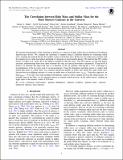Files in this item
The correlation between halo mass and stellar mass for the most massive galaxies in the universe
Item metadata
| dc.contributor.author | Tinker, Jeremy L. | |
| dc.contributor.author | Brownstein, Joel R. | |
| dc.contributor.author | Guo, Hong | |
| dc.contributor.author | Leauthaud, Alexie | |
| dc.contributor.author | Maraston, Claudia | |
| dc.contributor.author | Masters, Karen | |
| dc.contributor.author | Montero-Dorta, Antonio D. | |
| dc.contributor.author | Thomas, Daniel | |
| dc.contributor.author | Tojeiro, Rita | |
| dc.contributor.author | Weiner, Benjamin | |
| dc.contributor.author | Zehavi, Idit | |
| dc.contributor.author | Olmstead, Matthew D. | |
| dc.date.accessioned | 2017-06-08T14:30:08Z | |
| dc.date.available | 2017-06-08T14:30:08Z | |
| dc.date.issued | 2017-04-20 | |
| dc.identifier | 250203728 | |
| dc.identifier | 27bd0bcd-d997-443b-bc43-ff9f5b4307ee | |
| dc.identifier | 85018986223 | |
| dc.identifier | 000400087400011 | |
| dc.identifier.citation | Tinker , J L , Brownstein , J R , Guo , H , Leauthaud , A , Maraston , C , Masters , K , Montero-Dorta , A D , Thomas , D , Tojeiro , R , Weiner , B , Zehavi , I & Olmstead , M D 2017 , ' The correlation between halo mass and stellar mass for the most massive galaxies in the universe ' , Astrophysical Journal , vol. 839 , no. 2 , 121 . https://doi.org/10.3847/1538-4357/aa6845 | en |
| dc.identifier.issn | 0004-637X | |
| dc.identifier.uri | https://hdl.handle.net/10023/10951 | |
| dc.description | I.Z. is supported by NSF grant AST-1612085. Funding for the Sloan Digital Sky Survey IV has been provided by the Alfred P. Sloan Foundation, the U.S. Department of Energy Office of Science, and the Participating Institutions. SDSS-IV acknowledges support and resources from the Center for High-Performance Computing at the University of Utah. | en |
| dc.description.abstract | We present measurements of the clustering of galaxies as a function of their stellar mass in the Baryon Oscillation Spectroscopic Survey. We compare the clustering of samples using 12 different methods for estimating stellar mass, isolating the method that has the smallest scatter at fixed halo mass. In this test, the stellar mass estimate with the smallest errors yields the highest amplitude of clustering at fixed number density. We find that the PCA stellar masses of Chen et al. clearly have the tightest correlation with halo mass. The PCA masses use the full galaxy spectrum, differentiating them from other estimates that only use optical photometric information. Using the PCA masses, we measure the large-scale bias as a function of M∗ for galaxies with log M∗ ≥ 11.4, correcting for incompleteness at the low-mass end of our measurements. Using the abundance matching ansatz to connect dark matter halo mass to stellar mass, we construct theoretical models of b (M∗) that match the same stellar mass function but have different amounts of scatter in stellar mass at fixed halo mass, σlog M∗. Using this approach, we find σlogM∗ = 0.18 -0.02 +0.01. This value includes both intrinsic scatter as well as random errors in the stellar masses. To partially remove the latter, we use repeated spectra to estimate statistical errors on the stellar masses, yielding an upper limit to the intrinsic scatter of 0.16 dex. | |
| dc.format.extent | 11 | |
| dc.format.extent | 918246 | |
| dc.language.iso | eng | |
| dc.relation.ispartof | Astrophysical Journal | en |
| dc.subject | Cosmology: observations | en |
| dc.subject | Galaxies: abundances | en |
| dc.subject | Galaxies: evolution | en |
| dc.subject | Galaxies: halos | en |
| dc.subject | Galaxies: luminosity function, mass function | en |
| dc.subject | QB Astronomy | en |
| dc.subject | QC Physics | en |
| dc.subject | Astronomy and Astrophysics | en |
| dc.subject | Space and Planetary Science | en |
| dc.subject | 3rd-DAS | en |
| dc.subject.lcc | QB | en |
| dc.subject.lcc | QC | en |
| dc.title | The correlation between halo mass and stellar mass for the most massive galaxies in the universe | en |
| dc.type | Journal article | en |
| dc.contributor.institution | University of St Andrews. School of Physics and Astronomy | en |
| dc.identifier.doi | 10.3847/1538-4357/aa6845 | |
| dc.description.status | Peer reviewed | en |
This item appears in the following Collection(s)
Items in the St Andrews Research Repository are protected by copyright, with all rights reserved, unless otherwise indicated.

